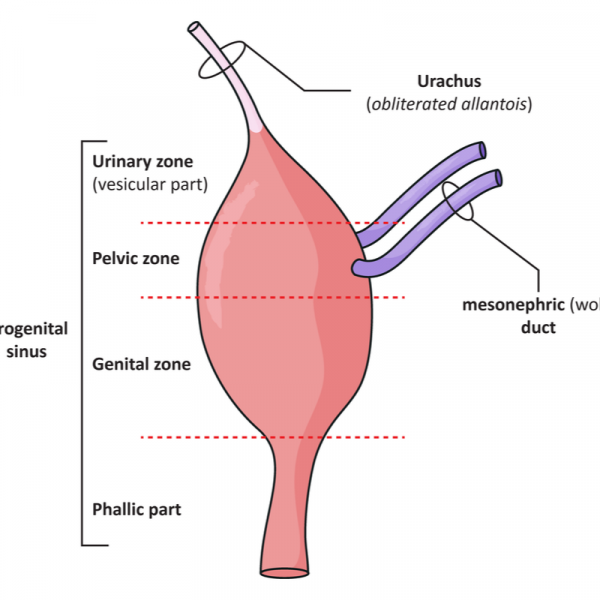
What is urachal carcinoma?
Urachal carcinoma is an aggressive and malignant (malignant), but rare form of tumour that affects the urinary tract. The tumour occurs more frequently in men who have reached the age of 50 (about 63 percent). Only between 0.5 and 2 per cent of all bladder tumours are due to urachal carcinoma. It is divided into a primary cystic and a non-cystic form. Urachal carcinoma often grows into the roof of the bladder, but it can also develop in the abdominal wall or the abdominal cavity and does not cause any symptoms for a long time.
How does a urachal carcinoma develop?
The cancer originates from the urachal duct (urachus), an elongated structure that developed during the embryonic phase. The urachus includes the apex of the later urinary bladder and extends into the umbilical cord. Although the urachus changes into a small band after birth, it can still be found in about one third of all adults. Signs of a preserved urachus are:
- recurrent inflammation of the urinary bladder and/or umbilicus,
- (increased) mucus production of the bladder and/or umbilicus,
- Umbilical hernia that has not been diagnosed as a preserved urachus.
Usually, however, the urachus does not cause any complaints. Only when cancer cells form in the urachus is it called urachal carcinoma.
What are the risk factors for developing cancer of the urachus?
It is not yet clear which risk factors can favour the development of a cancer of the urachus. However, doctors suspect that chronic inflammation, which leads to glandular metaplasia (the transformation of one type of cell into another), can also cause the development of a carcinoma later on. However, chronic inflammation can also lead to mucus retention, which in turn can cause a painful cyst on the anterior abdominal wall. This can promote urachal carcinoma via the belly button. But the fact that part of the urachus or the entire urachus remains increases the risk of tumour formation. In addition, doctors have so far ruled out a genetic predisposition, environmental factors or a familial predisposition for the development of a urachal carcinoma.
What stages is urachal carcinoma classified into?
Urachus carcinoma is classified according to the severity and aggressiveness of the tumour. The cancer stage is determined on the basis of the following aspects:
- the biopsy of the tissue sample,
- the tumour size,
- the tumour findings, whether neighbouring organs or tissues are already affected,
- the findings, whether the tumour has already metastasised.
What are the symptoms of urachal carcinoma?
Urachal carcinoma usually causes rather unspecific symptoms. Only when the tumour has reached neighbouring structures or has broken through the skin or mucous membrane can the first symptoms appear. Since the urachal carcinoma usually develops in the immediate vicinity of the urinary bladder wall or the urinary bladder, it can cause macrohaematuria, i.e. a red colouring of the urine. Since blood in the urine can also indicate other diseases, a doctor should always be consulted and the cause clarified. Irritation of the bladder or recurrent bladder infections can also be a sign of urachal carcinoma.
If, on the other hand, the urachus carcinoma has grown in a different place, for example within the Retzius space, this can lead to other symptoms, such as a rather rare umbilical discharge from the belly button (omphalorrhoea) or mucus in the urine (mucusuria).
How is urachal carcinoma diagnosed?
In the majority of cases, urachal carcinoma is usually discovered by macrohaematuria. In order to clarify this phenomenon, the doctor will usually perform a urethrocystoscopy (examination of the urethra and bladder). In 89 percent of all cases, urochal carcinoma can be detected by this examination, as the tumour typically occurs on the bladder roof or bladder wall. In addition, other imaging procedures can be used, such as magnetic resonance imaging (MRI) or computer tomography (CT).
If there is a well-founded suspicion that a cancer of the urachus is present, a biopsy will also be ordered. However, to obtain the cell tissue, a surgical procedure must first be performed, during which the patient is put under general anaesthesia. The removal of a tissue sample from the urinary bladder is usually done by a transurethral resection (TUR). This involves inserting an endoscope through the urethra into the bladder to remove a tissue sample.
How is urachal carcinoma treated?
Since most cases of urachal carcinoma do not show any symptoms for a long time, it is usually only discovered at a rather advanced stage. If possible, the doctor treating the patient will always try to remove the tumour completely by surgery. If parts of the bladder are already affected, these must also be removed. In very rare cases, it may be necessary to remove the entire organ. During the operation, a replacement reservoir, a so-called neobladder, is inserted or a urinary stoma is constructed. This is an artificial opening for urination. It may also be necessary to remove pelvic lymph nodes if they are enlarged or affected by the cancer.
Unlike other cancers, systemic chemotherapy for urachal carcinoma is not a substitute for surgery and cannot cure the tumour. Chemotherapy is therefore usually only used if the urachal carcinoma has spread to other tissues or organs and/or to prevent a possible relapse (risk of recurrence) after successful surgery.
What is the prognosis for urachal carcinoma?
Urachus carcinoma is usually only diagnosed when the patient complains of the first symptoms. At this point, however, in 20 percent of all cases it is no longer possible to cure the urochus carcinoma. About every third patient either suffers a relapse after therapy or the tumour even spreads. The 5-year survival rate after diagnosis is 50 percent.
